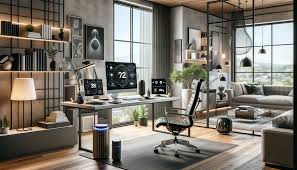
Creating an efficient and productive home office setup involves more than just finding a comfortable chair and desk. The right technology can significantly impact your productivity and overall work experience. Here’s a comprehensive guide to help you choose the best tech for your home office.
1. Assess Your Needs
Before diving into the world of tech gadgets and software, it’s crucial to assess your specific needs. Consider the following questions:
- What type of work will you be doing? The tech requirements for a graphic designer might differ greatly from those of a financial analyst.
- How many people will use the space? A multi-user setup may need different considerations compared to a single-user space.
- What is your budget? Establishing a budget will help narrow down your options and prevent overspending.
2. Choosing the Right Computer
The computer is the heart of your home office setup. Here are some factors to consider:
Desktop vs. Laptop
- Desktop: Offers more power and upgradeability. Ideal for tasks requiring high performance, such as video editing or gaming. It also provides better ergonomics with adjustable monitors and separate keyboards.
- Laptop: Provides flexibility and space-saving benefits. Modern laptops are powerful enough for most professional tasks and are portable, allowing you to work from different locations within your home.
Specifications
- Processor (CPU): Choose a powerful processor like Intel i5/i7 or AMD Ryzen 5/7 for efficient multitasking and handling demanding applications.
- Memory (RAM): A minimum of 8GB is recommended, but 16GB or more is ideal for heavier workloads and multitasking.
- Storage: Opt for a solid-state drive (SSD) for faster performance. Consider 256GB or more, depending on your data storage needs.
- Graphics Card: If your work involves graphics-intensive tasks, a dedicated GPU might be necessary.
3. Monitors and Displays
A good monitor can enhance your productivity and reduce eye strain. Consider the following factors:
Size and Resolution
- Size: A larger monitor (27 inches or more) provides more screen real estate and can reduce the need for multiple monitors.
- Resolution: Full HD (1920×1080) is sufficient for most tasks, but 4K (3840×2160) offers sharper details, which can be beneficial for design work or detailed data analysis.
Features
- Adjustability: Look for monitors with height, tilt, and swivel adjustments to improve ergonomics.
- Blue Light Filtering: Monitors with blue light filtering can reduce eye strain during long working hours.
4. Keyboards and Mice
The right input devices can greatly affect your comfort and efficiency:
Keyboards
- Ergonomic Keyboards: Designed to reduce strain on your wrists and hands. They come in various styles, including split and curved designs.
- Mechanical Keyboards: Offer tactile feedback and durability, which can be beneficial for typing accuracy and comfort.
Mice
- Ergonomic Mice: Designed to fit the natural curve of your hand, reducing wrist strain. Vertical mice can also help with wrist alignment.
- Precision Mice: Features like adjustable DPI (dots per inch) settings can improve accuracy for detailed work.
5. Printers and Scanners
Even in the digital age, printers and scanners are essential for many home office tasks:
Printers
- Inkjet Printers: Good for high-quality color printing and occasional use. Ideal for printing photos or marketing materials.
- Laser Printers: Better for high-volume, black-and-white printing. They offer faster speeds and lower cost per page.
Scanners
- Flatbed Scanners: Versatile and capable of scanning various document sizes and types. Good for detailed scanning of books, photos, and documents.
- Document Scanners: Designed for fast, high-volume scanning of documents. Look for features like automatic document feeders (ADFs) for increased efficiency.
6. Networking Equipment
A reliable network is crucial for a productive home office:
Routers
- Dual-Band Routers: Support both 2.4 GHz and 5 GHz frequencies, providing better speed and range.
- Mesh Network Systems: Consist of multiple units working together to provide seamless coverage throughout your home.
Ethernet vs. Wi-Fi
- Ethernet: Offers a stable and high-speed connection. Ideal for tasks requiring a lot of bandwidth, such as video conferencing or large file transfers.
- Wi-Fi: Provides flexibility and convenience. Ensure your router supports the latest Wi-Fi standards (e.g., Wi-Fi 6) for better performance and coverage.
7. Audio and Video Equipment
For virtual meetings and communication, high-quality audio and video equipment are essential:
Webcams
- Resolution: Look for at least 1080p resolution for clear video quality. Higher resolutions like 4K can offer even sharper images.
- Built-in Microphones: Some webcams come with built-in microphones, but external microphones often provide better sound quality.
Headsets and Speakers
- Headsets: For clear communication and noise isolation. Look for models with a built-in microphone and comfortable ear cushions.
- Speakers: Quality speakers can enhance your audio experience for meetings, presentations, or leisure activities.
8. Additional Accessories
Consider these accessories to further enhance your home office setup:
Docking Stations
- Docking Stations: Allow you to connect multiple peripherals (monitors, keyboard, mouse) to your laptop through a single connection, streamlining your workspace.
Cable Management
- Cable Management Solutions: Help keep your cables organized and reduce clutter. Look for cable clips, sleeves, or cable organizers.
UPS (Uninterruptible Power Supply)
- UPS: Provides backup power during outages and protects your equipment from power surges.
Conclusion
Selecting the best tech for your home office involves understanding your specific needs and finding the right combination of devices to enhance productivity and comfort. By carefully considering each aspect of your setup, from computers and monitors to audio equipment and networking, you can create an efficient and effective home office environment. Remember, investing in quality tech can pay off in the long run, improving your work experience and overall productivity.








